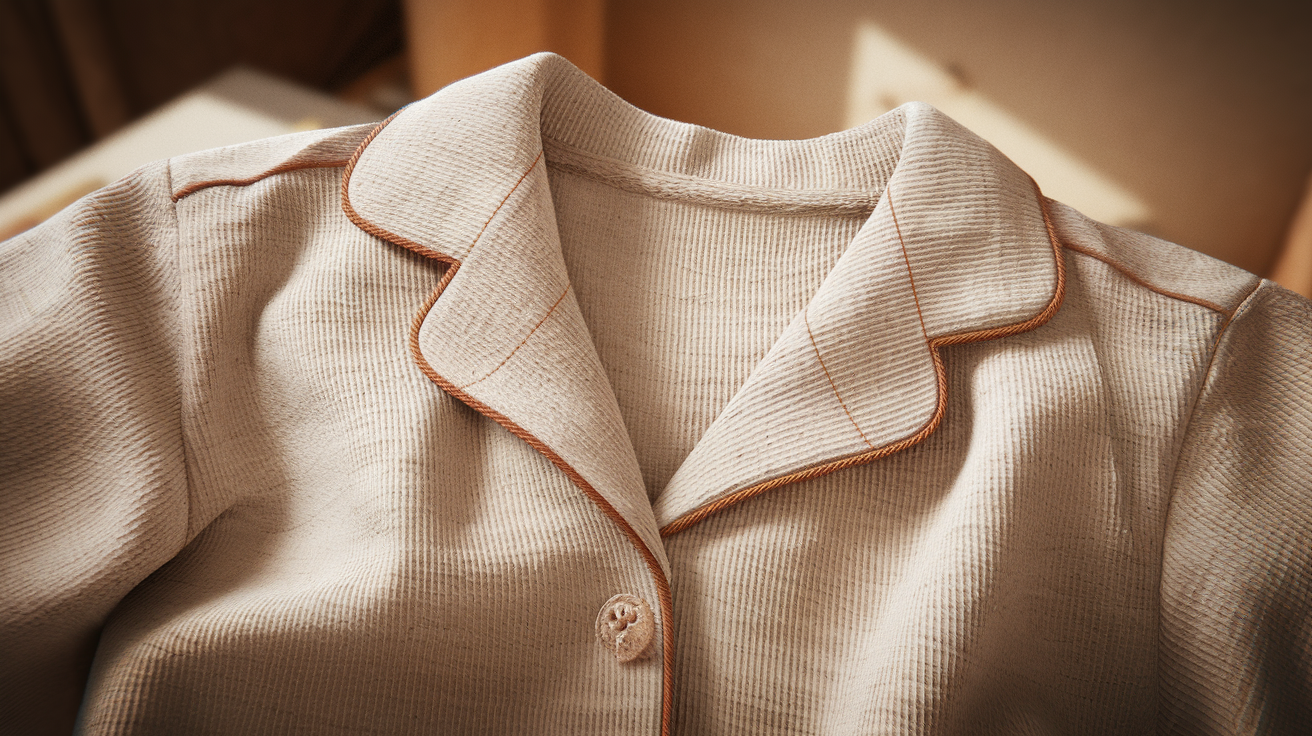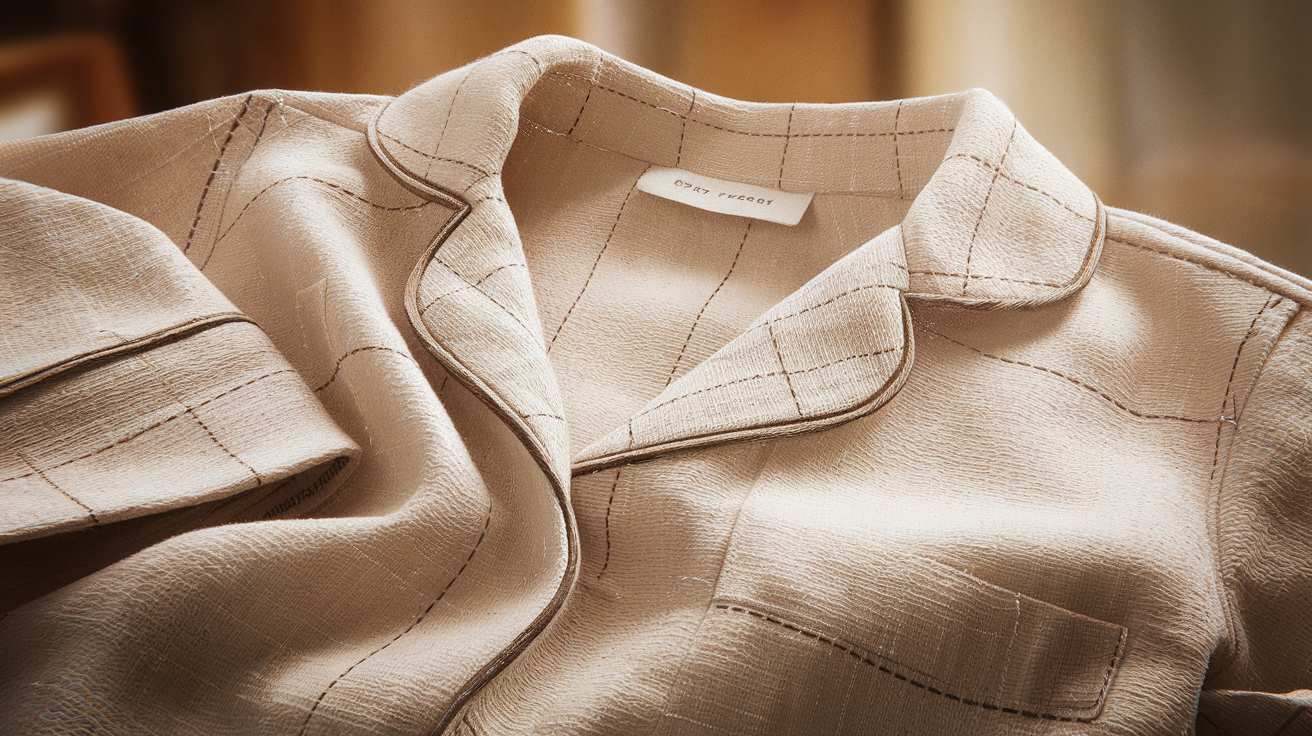How To Sew A Unisex Pajama Top Free Pattern

Dreaming of a loungewear wardrobe upgrade? Download our free sewing pattern and explore the world of gender inclusive, DIY sleepwear crafted for every body. Featuring a relaxed fit, this pattern empowers both beginner sewing enthusiasts and intermediate makers to create a comfortable, personalized pajama shirt.
Apparel construction skills are honed as you follow step-by-step craft instructions, from cutting fabric and marking grainlines to mastering buttonholes and adding piping detail for a stylish finish.
Your handmade garments will not only feel luxurious but also reflect your own style and seasonal clothing needs.
Begin this home sewing adventure and transform simple fabric choice into truly stylish loungewear favorites.
Choosing Your Fabric
Selecting the right material is the first step for any successful unisex pajama project. Fabric choice significantly impacts the comfort and feel of your finished garment.
For a breathable and easy-care option, cotton fabric remains a classic pick, while silk fabric delivers an opulent touch for those seeking luxury. Consider flannel fabric for cozy winter nights or linen fabric for breezy, year-round wear.
DIY sleepwear projects benefit greatly from using pre-washed woven fabrics, which helps prevent shrinkage and ensures a consistent finish after your initial garment assembly.
Pay close attention to drape; a lightweight fabric like rayon produces a flowing, relaxed fit, making every handmade top feel exceptionally inviting and truly comfortable clothing for all genders.
Textile selection plays a role in the overall feel. Think about the tactile experience different materials offer for optimal comfort.
Pre-washed options simplify the process, saving you time and preventing unexpected shrinkage.
Drape is important; consider how it affects the final garment’s flow and fit.
For instance, double gauze offers a soft, slightly crinkled texture perfect for relaxed tops, and this mediumweight fabric is also quite forgiving for beginner sewing.
When working with delicate materials like silk fabric or fine rayon, opting for a serger or a neat zigzag stitch for seam finishing ensures durability and a professional appearance, especially around the collar styles and sleeve options.

Preparing Your Free Pajama Pattern
Embarking on your DIY sleepwear adventure begins with meticulously organizing all your downloadable patterns before touching any cotton fabric or flannel fabric. For those crafting a unisex pajama set, it is essential to carefully cross-reference each component with the accompanying fabric layout diagram, ensuring maximum efficiency and minimizing material waste—a common tip from many free sewing pattern resources.
Examine the notches, grainlines, and sizing markers; these critical fabric markings on every single pattern piece are instrumental in achieving that desired relaxed fit and impeccable drape.
Beginner sewing enthusiasts are strongly encouraged to compare their personal measurements against the pattern, making straightforward adjustments to bodice or sleeve lengths for a truly comfortable and custom result.
Transition smoothly into the subsequent phase by confirming the clarity and readiness of each piece—your cut will be significantly more precise, and the subsequent assembly will be considerably simpler, making this a truly easy sewing process.
Sleepwear sewing requires careful attention.
Sewist resources suggest this.
Stylish pajama creation involves preparation. Comfortable clothing starts with a good plan.
Genderinclusive designs are accessible.
Downloadable patterns simplify custom fits.
Sewing tutorial clarity is key. Piping detail adds charm.
Buttonup shirt construction needs accuracy. Easy sewing makes it fun.
Beginner sewing skills develop here.
Crafting supplies are ready.
Apparel construction knowledge grows.
Your handmade garments will be perfect with careful preparation.
Sewing guide, craft instructions, pajama shirt comfort.
Cutting Your Pajama Pieces with Precision
Cutting fabric with absolute precision is paramount for crafting a wonderfully comfortable top and effortlessly stylish loungewear, especially when working with the soft touch of cotton fabric or the light feel of linen fabric.
For optimal results in your pajama shirt, it is imperative that the grainlines are perfectly aligned parallel to the selvage edge, following the large arrow indicated on the pattern, to effectively prevent distortion and guarantee proper draping. As you pursue fashion sewing success, expertly pin your pattern pieces through all fabric layers, placing pins perpendicularly to the cut lines to prevent any shifting while you use your sharp shears.
Employ dressmaker’s chalk or specialized fabric marking pens to transfer all notches and markings accurately; these essential sewing techniques contribute to maintaining a tidy and professional appearance for your craft project.
By concentrating on accurate grainline alignment and executing crisp cuts, your unisex pajama top will assemble beautifully and offer a wonderfully flexible sizing.
Sewist resources highlight cutting accuracy.
Sewing techniques ensure clean edges. Piping detail requires care.
Buttonup shirt pieces are precise. Comfortable clothing relies on good cuts.
Downloadable patterns guide you well.
Easy sewing starts with accurate cutting.
Beginner sewing projects benefit greatly. Flannel fabric can be bulky.
Sewing guide details this. Pajama shirt fit depends on accuracy.
Stylish pajama results are rewarding.
Sharp shears and careful pinning prevent fabric shifting.
Fabric choice, mediumweight fabric, seam finishing.
- Properly aligning grainlines parallel to the selvage edge prevents fabric distortion and ensures correct draping for a comfortable fit.
- Transferring notches and markings accurately using dressmaker’s chalk or fabric pens is crucial for professional-looking results and easier assembly.
- Comparing personal measurements to the pattern and making adjustments to bodice or sleeve lengths leads to a more comfortable and custom-fit garment.
- Meticulously organizing downloadable patterns and cross-referencing components with fabric layout diagrams minimizes material waste and maximizes efficiency.
Assembling the Button-Up Shirt
Precision matters at every stage when constructing your unisex pajama top, from fabric cutting to final assembly. Free sewing pattern pieces should be cut from your chosen cotton, silk, or flannel fabric after carefully marking notches and grainlines for accurate alignment.
Begin by sewing the optional patch pocket onto the front facings, ensuring straight topstitching for a polished look.
Attaching the front facings at the neckline next keeps edges clean, while proper joining of shoulders and careful setting of sleeves achieves a relaxed fit.
Pressing each seam as you go and opting for French seams or zigzag stitch finishing techniques results in a buttonup shirt that looks professional inside and out. Matching fabric patterns across seams will help your DIY sleepwear appear seamless and refined, setting the stage for the next steps in your loungewear wardrobe.
Adding Stylish Loungewear Details
Elevate your pajama shirt with just a few thoughtful additions, making comfortable clothing feel like stylish loungewear.
Contrast piping along the collar, pocket, or front edge adds a classic, high-end accent and can be easily inserted using a sewing machine and careful seam finishing. Mark and create buttonholes with precision, then select unique buttons—these small choices can dramatically impact your sleepwear sewing project’s final look.
For personalized flair, consider using a bold or coordinating fabric choice on the cuffs or collar, tapping into gender inclusive trends or seasonal clothing possibilities.
After all details are added, a final press ensures your handmade garment looks and feels truly professional, ready for gifting or daily comfort in your loungewear wardrobe.
- Precision in fabric cutting, including marking notches and grainlines, is crucial for accurate alignment when constructing the unisex pajama top.
- Techniques like French seams or zigzag stitch finishing are recommended for professional-looking seams, both inside and out, on the button-up shirt.
- Adding contrast piping, precise buttonholes, and unique buttons are suggested details to elevate a pajama shirt into stylish loungewear.
- Matching fabric patterns across seams contributes to a seamless and refined appearance for DIY sleepwear.
Personalizing Your Gender-Neutral Fashion
Designing a unisex pajama top offers a unique opportunity to let your personality shine while focusing on practicality and self-expression. Pocket placement delivers everyday functionality for a DIY sleepwear project; consider whether a traditional chest patch pocket or a hidden side seam enhances where you keep essentials such as your phone or glasses.
Embroidery is perfect for a personal touch—try initials, peaceful motifs, or calming words to mark your pajama shirt as truly your own, using cotton fabric or flannel fabric for easy stitching.
Versatility means your handmade garment can move from sleepwear to stylish loungewear, especially when you play with fabric choice and color.
Personal touches, like thoughtfully placed detail, make this free sewing pattern a springboard for your unique genderneutral fashion journey.
Simple Sewing Tutorial Steps
Crafting your comfortable top starts with understanding each sequence in the sewing tutorial, ensuring every stage flows smoothly for all skill levels. Beginner sewing enthusiasts benefit from breaking down each construction phase—such as cutting fabric, marking notches, grainlines, assembling sleeves, and adding buttonholes—into small, easy sewing steps.
Illustrations and diagrams in sewing guides are invaluable for clarifying tricky parts like sewing collar styles, inserting sleeves, or attaching piping detail. Practicing on scrap fabric with your sewing machine before approaching the main garment boosts confidence and polishes results, especially when learning techniques like zigzag stitch or hemming.
Thoughtfully mastering these processes builds both your garment assembly skills and a handmade loungewear wardrobe that balances both comfort and style.
- Pocket placement on a pajama top can be customized for everyday functionality, allowing for storage of essentials like phones or glasses.
- Embroidery, such as initials or calming words, can be used to personalize a pajama shirt, especially on easy-to-stitch fabrics like cotton or flannel.
- The choice of fabric and color can transform a handmade pajama top into versatile loungewear, moving beyond its sleepwear function.
- Breaking down sewing tutorial steps, like cutting fabric, marking, and assembling sleeves, into smaller, manageable stages benefits beginner sewing enthusiasts.
Finishing Your Comfortable Top
Sewing tutorial creators emphasize that strategic hemming options can dramatically change a garments look, offering a polished conclusion to your comfortable top. Selecting the right hem, whether it’s a simple turned hem or a more decorative one, elevates the overall aesthetic of your DIY sleepwear, making it suitable for any season.
Pressing the final garment is as important as sewing it; this step ensures crisp seams and a professional finish, transforming your handmade garment from a craft project into stylish loungewear.
Professionals advise a good press after each major construction step for optimal results.
To ensure longevity and durability for your genderneutral fashion piece, it’s essential to reinforce stress points. These areas, typically around armholes, collar points, and pocket corners, benefit from a few extra stitches, perhaps a short zigzag stitch or a reinforced backstitch, guaranteeing your creation withstands wear and frequent washing, extending its life in your loungewear wardrobe.
Adding Professional Touches
Apparel construction techniques for your unisex pajama, whether from a free sewing pattern or custom design, often include thoughtful details.
The inclusion of piping detail can add a sophisticated contrast piping along seams, pockets, or collars, enhancing the visual appeal of your pajama shirt. When employing techniques such as adding piping, handling bulk with your sewing machine or serger becomes an important sewing technique to master.
This pajama shirt, a fantastic example of beginner sewing or intermediate sewing, offers opportunities to experiment with various collar styles and sleeve options, allowing for personalization.
A well-executed patch pocket not only adds a functional element but also serves as a prime location for contrast piping.
Creating neat buttonholes for a classic buttonup shirt requires precision, a key skill in garment making and sleepwear sewing.
Fabric Choices and Preparation
Fabric choice is paramount for creating truly comfortable clothing. For cozy DIY sleepwear, consider the tactile qualities of cotton fabric, the luxurious feel of silk fabric, or the warmth of flannel fabric.
For a more breathable option, linen fabric or rayon fabric are excellent; double gauze offers a soft, airy drape ideal for warm weather. Most woven fabrics will work well; consult your sewing guide for specific recommendations regarding lightweight fabric and mediumweight fabric suitability for your chosen pattern.
Proper preparation involves careful cutting fabric, paying close attention to grainlines, and accurately marking notches, which are essential for successful garment assembly and ensure a proper fit for your relaxed fit project.
Essential Assembly Steps
This sewing tutorial for a comfortable top guides you through several key assembly stages.
Begin by attaching any decorative elements like piping detail to the relevant pattern pieces, such as the front facing or pocket.
After successfully sewing the pocket and piping, proceed to attach the front facing to the shirt body, a precise step in apparel construction. Joining the shoulder seams forms the basic structure, followed by setting in the sleeves; sometimes, gathering stitches are helpful here for a smooth sleeve set.
Your pajama shirt construction continues with sewing the side seams, creating a clean finish with a zigzag stitch or serger for seam finishing ensures the inside looks as good as the outside. Hem finishing for both the bottom and sleeves should be done last, completing the handmade garments.
Personalization and Final Touches
Stylish loungewear often comes down to personalization, and this free sewing pattern project offers ample opportunity for creativity.
Experiment with different fabric choices, perhaps using a printed cotton fabric for the main body contrasted with a solid color for the collar and cuffs.
Adding contrast piping to seams or pockets can provide a striking visual accent.
Explore various collar
Key Takeaways for Sewing a Comfortable Top
- Strategic hemming options and proper pressing are crucial for a polished and professional finish on handmade garments.
- Reinforcing stress points with extra stitches, like a zigzag stitch or reinforced backstitch, enhances the longevity and durability of the garment.
- Thoughtful details such as piping, contrast fabrics, and neat buttonholes contribute to the sophisticated aesthetic of apparel construction.
- Careful fabric preparation, including accurate cutting and marking of grainlines and notches, is essential for successful garment assembly and a proper fit.




